Learn here how to compost with worms and how to either build your own worm bin or check out my favorite online picks! Whether you are growing your own food inside or out, a worm composting bin is great to turn household food scraps into “black gold”. Worm castings are the richest natural fertilizer known to humans. That’s right: as little as a tablespoon of pure worm castings provides enough organic plant nutrients to feed a 6″ potted plant for more than two months. Worm castings stimulate plant growth more than any other natural product on the market. Unlike animal manure and artificial fertilizers, it is absorbed easily and immediately by plants. Worm castings don’t only stimulate plant growth: they also enhance the ability of your soil to retain water (because of its texture), and it even inhibits root diseases such as root rot.
Worm castings contain minerals and are a 100% organic fertilizer that can increase a plant’s yield, protect both soil and plants from diseases and help the soil retain moisture. When seeds or plants are planted in a soil right in castings, this pest-resistance is then transferred to the plant.
How to Compost with Worms – Make and Use Your Own Worm Bin
You can build your own vermicomposter or worm bin or buy one of the many offered online. They must be kept inside as extreme heat fluctuations will kill your worms.
This great video from the University of Maine shows you how to build your own!
You will need a large plastic bin (about 8 or so gallon size) with a lid and a plastic tray to put under it that is about 4-6 inches deep. Drill about 10-12 1/4 inch holes all over the bottom of the large bin. Also, drill 1/2 inch holes about 4 inches apart around the top of the bin for aeration. 
Make bedding for the worms by combining paper, dry leaves, soil and just enough water to dampen everything. Put the mixture into the tall bin and fill the bin about three inches deep. Add your worms to the mixture and let them get used to it for a day before feeding them. Make sure the mixture is moist, but not forming puddles of water.
What to Feed Your Worms
Collect food scraps, such as vegetables and fruit scraps, bread, tea bags, coffee grounds and filters, and cereal in your food scrap container as you prepare and clean up after meals. Do not include any animal by-products (fat, bone, dairy, meat, waste). Also, it may take the worms longer to process woody or dry items like stems. I use an old ice cream container to collect my scraps and then freeze them. This helps to break down the cellular structure of the food before the worms even get to it. Thaw thoroughly before adding to the bin. This is optional but speeds up the process.
You should use an equal amount of food scraps to carbon. Carbon can be dry leaves or any kind of shredded paper except for glossy paper. Bury the kitchen scraps in the bedding, starting in one corner and then in different places going in a clockwise direction around the bin. The worms will naturally migrate to the fresh food once they are done with the old. If your bin starts to develop an off odor or fruit flies, use more shredded paper on top.
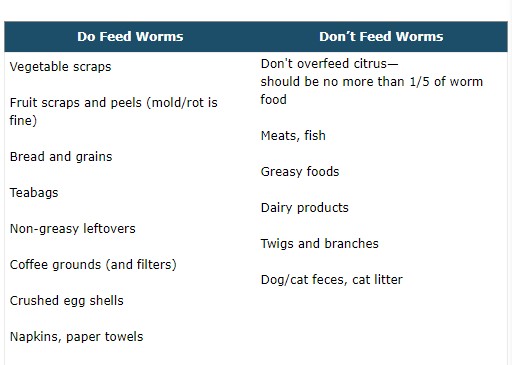
Put bricks or old plant pots into the bottom tray and put the large compost bin on top of it. This will allow for excess drainage of water in case you should accidentally put too much water in the bedding.
Please note that this site is supported by affiliate marketing which means that a small portion will be paid to maintain this site from any purchases made through it. This in no way affects the price of the products on this page.
What Kind of Worms?
Remember the show “WKRP in Cincinnati” and the jingle, “Red Wigglers, the Cadillac of worms”? Well, they really are! Normal earthworms die in a worm composter as they are used to digging down much deeper into cool soil. You can buy red wigglers from bait shops, horticulture stores or get them from fellow “worm composters”. One pound should do and they readily reproduce if there is more food than they can handle.
Click HERE to buy on Amazon (Apologies – worms are not available at Amazon at this time – perhaps because its winter).
Want to Read More?
I found an excellent book on vermicomposting and this is The Worm Farming Revolution Book. The Worm Farming Revolution book is full of information, tips & techniques, photos, charts, inspirational quotes, coloring pages, facts, composting terms, how to harvest & use worm castings on your plants, how to grow healthy, large & pest-free vegetation, and on and on. Click here for full product information.
Commercial Worm Bins Makes Composting with Worms Easy!
All of these bins have stackable trays that allow your worms to finish off one level before moving on up to the next level. This saves you work in screening out the compost in order to save your worms and makes things much easier. Make very sure that you use an equal amount of bedding (shredded paper or leaves) to food scraps in these units in order to avoid anaerobic decomposition, foul odors or flies. If you follow this simple rule, all of these composters make vermicomposting so much simpler and pretty much “idiot-proof”.
Worm Factory 360
I have been using the Worm Factory 360 for years now and it is my hands-down favorite. It comes with:
- A standard 4-Tray size which is expandable up to 8 trays, giving it the largest volume of any home composter.
- The redesigned lid converts to a handy stand for trays while harvesting the compost.
- Includes a digital instructional manual with a step-by-step guide for managing your Worm Factory 360.
- Bonus “What Can Red Wigglers Eat?” infographic refrigerator magnet (6″ by 9″) allows you to quickly determine which foods are perfect for your worms, and which you should avoid. Imagine the peace of mind you will feel knowing that your worms are always eating a healthy diet!
- Built-in “worm tea” collector tray and spigot for easy draining.
Click HERE to see in Amazon.
Hot Frog Living Composter
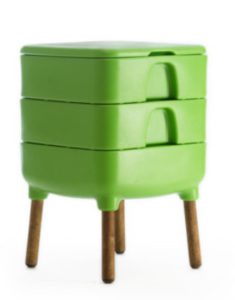 The HOT FROG Living Composter (Vermicomposter) is the 2nd generation of worm composters created by FCMP Outdoor. They’ve incorporated some terrific design updates in our latest version.
The HOT FROG Living Composter (Vermicomposter) is the 2nd generation of worm composters created by FCMP Outdoor. They’ve incorporated some terrific design updates in our latest version.
1) A moisture control water retention channel runs around the outside of each tray. Instead of allowing the liquids to fall directly through the tray this channel gathers moisture to prevent the bedding from drying out along the edges.
2) When it’s time to expand your living composter a collection of 40 angled tunnels extend down from the base of each tray directly into the bedding of the tray below. This provides ample opportunity for worms to migrate between trays.
3) Aeration is important for happy worms and good compost. A series of support points are molded into the lower edge of the trays. This raises the trays slightly allowing 360 degrees of airflow across the bedding.
4) The double-walled lid and base provide excellent insulation against temperature swings helping to maintain an ideal environment. Happy worms are productive worms.
5) The spigot on the bottom allows you to collect the worm tea easily with no mess!
Click HERE to see in Amazon.
VermiHut Plus 5-Tray Worm Compost Bin
- Increased airflow design: A new component named “worm-saving tray” or “M-Board” is built into the system. This component increases the system airflow for better compost efficiency. Plus, it prevents worms and bedding debris from dropping to the liquid tray. This is a unique design. Other brand names in the worm compost market don’t have this design.
- Odorless design: the worms consume the bacteria before it smells. A component named “V-Board” and a piece of coconut mat are built in the air-vented lid. The improved lid design removes the already minimal odor. The VermiHut Plus can be used inside or outside the house. This is a unique design. Other brand names in the worm compost market don’t have this design.
- Moisture Control: The improved lid design makes it possible for moisture control. The coconut fiber holds the moisture and keeps the environment moist. It maintains the bedding in a perfect moisture level and provides the worms a comfortable living environment. This is a unique design. Other brand names in the worm compost market don’t have this design.
- Fruit Fly Control: fruit fly eggs oftentimes come with fruit peels and may generate fruit flies, particularly in the summer months. The improved lid design can minimize fruit flies. This is a unique design. Other brand names in the worm compost market don’t have this design.
- Ant resistant design: A set of ant-trappers comes with the unit. In case of ants invading the worm bin, the ant-trappers are the ultimate defense. This is a unique design. Other brand names in the worm compost market don’t have this design.
Click HERE to see in Amazon
Please note that this site is supported by affiliate marketing which means that a small portion will be paid to maintain this site from any purchases made through it. This in no way affects the price of the products on this page.
How to Compost with Worms – Use a Worm Bin Conclusion
During the winter when you just don’t want to be trudging through feet of snow to the outdoor compost pile, any of these worm composting options will be your saving grace! All they take up is about 2 ft x 2 ft of space and can be put anywhere in your house or garage as long as they are kept at around room temperature. I just can’t recommend vermicomposting more to help keep our planet green and your plants in the best health they’ve ever been!
Let me know what you think of composting with worms and share your story, too! Don’t forget to hit follow for upcoming blogs and share with your friends!
Related Posts
Conventional vs. Organic Hydroponic Nutrients


0 (0) Are “Organic” nutrients really better for your system or for your customers? Find out in this video from…
Can You Profit From Hydroponics?
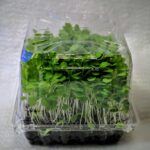

5 (8) Did you hear the story of a farmer who started growing strawberries? Yes? But, do you know he…

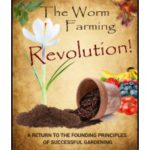
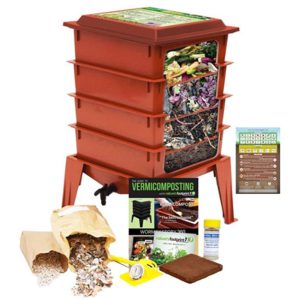



This is awesome and timely. Though we live in an apartment, we recently got the go-ahead to do some potted herbs and tomatoes. I had been worried about keeping the plants well fed beyond what was already in our potting mix, but this looks like a great solution and somewhat simple to set up.
Thanks very much for writing this and I look forward to hopefully doing some composting of my own in the future. In your opinion, is the DIY plastic bin method as effective as the retail worm bins?
Hiya Steve! Thank you and yes the DIY works just as well as the purchased ones – they just take a little more work. I would highly recommend you watch the video as it really shows all the steps better than words can explain. Have fun!
This is a really great post, my girlfriend is really interested in indoor gardening and she has been talking about compositing of worms by herself and I think it was crazy. She said it’ll be good for her plants and all . The way you have described the stems looks really interesting and I think I’ll get her one of this and even join her in learning all about it. Thanks for educating me
Hi Henderson – Nope! She’s not crazy! LOL You’re plants will love you for it and then you can move onto even growing your own food. Thank you for commenting!
One friend of mine who lives in the countryside has created some huge worm bins for composting. He suggested that I should do this as well but I live in the city and I thought that I didn’t have space.
However, those bins seem like the perfect solution. I’ll just try the smallest one which seems to be the Can-O-Worms. Thanks a lot!
Hi Harry – yes, these are compact enough that even apartment dwellers can use them! Thank you for your comment
My family has been composting with worms for years! My husband actually had a 4H class where he taught the kids how to compost, collect and sell the castings and harvest the tea, and make their own bins. My kids each had their own bin.
We only have 1 bin now, and I was actually looking into getting another one. One important feature to have is the spout for collecting the tea! I had one without this and it makes a mess. The spout makes it easy to drain.
Thank you for the information on the different bins. It really helps to have this all in one site to be able to compare them.
Thank you Karen! You bring up an important point that I missed – that this is a wonderful family thing to do and will teach children from an early age how to improve our planet!
Your article is educative to me,I have not come across of such an article before,this is great and it opened my eyes to what I learnt many years ago,I agreed with your statements which says worm castings contain minerals and are a 100% organic fertilizer.Keep it up great writer,you will surely rock more in online business.Thanks
Thank you so much Abayomi! I sure hope that more people go green rather than filling our landfills with perfectly usable food scraps and paper waste.
Simple information makes a lot of difference. In this situation, I didn’t know how simple and easy to make a natural environmental friendly fertilizer and more so it helps to recycle scraps food and other discarded materials into an amazingly useful application. It is good to know also which I can’t wait to apply all the recommended scraps which are good worm food basically smelly ones plus twigs and branches are not good worm foods. This would make gardening not only environmentally friendly but also avoid the unnecessary repulsive smell of rotting meat, feces of animals basically cats and dogs and fish. Filling up the soil with shredded paper as prevention of flies and some unacceptable odor.
Hiya! Yes, twigs are fine but as they are only worms, they can’t handle large branches. If you know someone with a wood chipper, though, you could easily add them once they have been broken down a bit. Shredded paper is really easy to come by and a good way to get rid of all of that junk mail!
Great article! My sister and I really wanted to try composting a while ago but it just seemed so high maintenance. This seems like it would be a lot easier! The Hot Frog Living Composter might even look cute in my basement. Does one of these take enough scraps to keep up with what you have leftover from everyday life? I have 2 kids and feel like we end up trashing more than we would like every meal.
To get started using this system is there anything else we would need besides the composter and the worms? How long would you say you spend on the process daily or weekly?
Thanks so much for the useful info!
Hi Angela! You can buy extra bins or levels for all three of the commercial composters so there is no way that a family of 4 could ever produce more kitchen waste than these can keep up with. All three come with perfectly good bedding to get you started. All you need add is shredded paper and your kitchen scraps. I used to go to offices and ask them for their shredded paper for this and they were happy to hand it over. Now I live in the middle of nowhere so I dished out $30 on a cheap paper shredder so now all of my junk mail and flyers also get consumed by the worms. Total win-win!
Hi Darlene, I love this article! Thanks for being so detailed. I’m really into sustainable methods of gardening and general lifestyle as well.. Your article taught me some really cool things about worm composting. I had no idea that worm diet was so important or varied either, but I can see how your plants would thank you for worm composting! I’m worried about the smell though… does it stink really badly?
Thanks!
Janani
Hi Janani! My composter produces 0 smell or flies. Just keep to the formula of 50/50 food scraps to carbon (leaves or shredded paper) and you won’t have a problem. Have fun with it!
Hello DARLENE!
Vey nice and very different article. So much informative as well. It seems you have gathered a good knowledge about gardening. In this era of urbanization, there is so little chance of gardening as there is shortage of lands. Though some people trybto make a small garden on either rooftops or balconies. But all can not be succeeded as they do not know how to cultivate or give proper nutrition. You have written so nicely about the worm composting that will help them for good gardening. thanks for that.
Hi Snigda! Thank you so much for your comments. The aim of this site is to encourage indoor gardening in small spaces to that even urbanites can participate and gain access to truly fresh and pesticide free food.